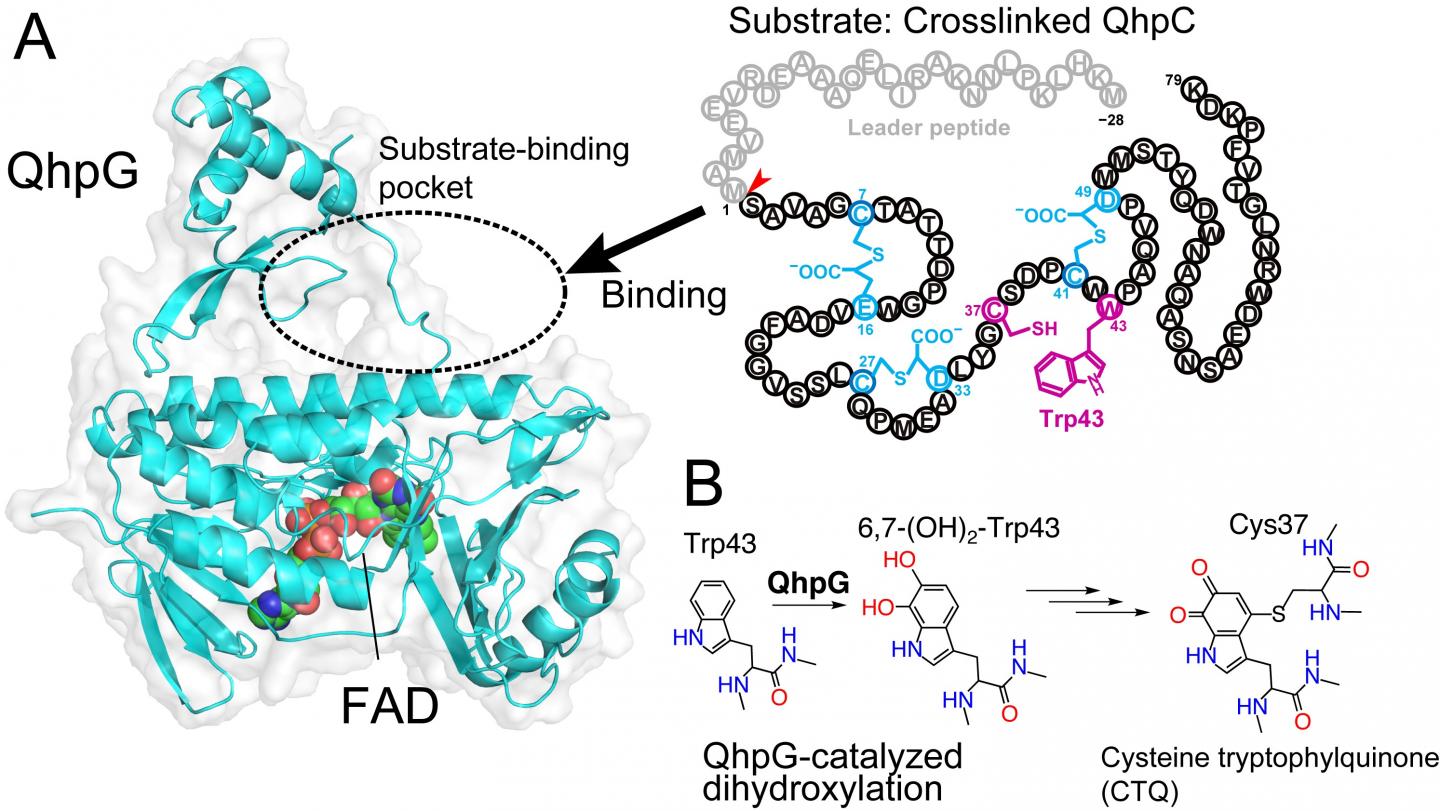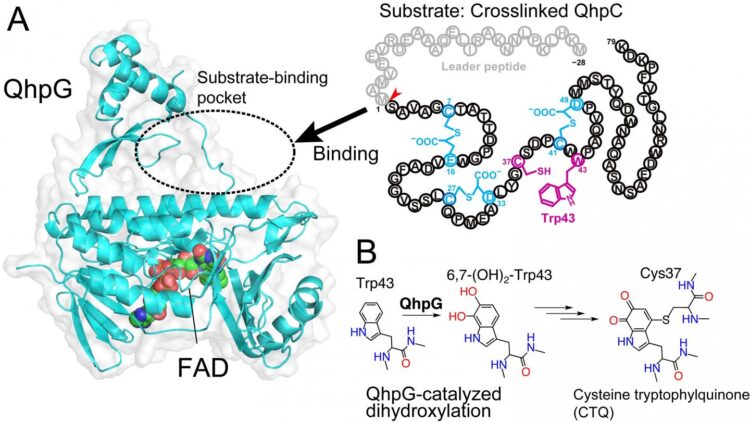A research team led by Osaka University has identified the protein used by the body to convert amino acids into the enzyme cofactor cysteine tryptophylquinone, which may lead to the development of novel biological catalysts

Credit: Osaka University
Osaka, Japan – Investigators from the Institute of Scientific and Industrial Research at Osaka University, together with Hiroshima Institute of Technology, have announced the discovery of a new protein that allows an organism to conduct an initial and essential step in converting amino acid residues on a crosslinked polypeptide into an enzyme cofactor. This research may lead to a better understanding of the biochemistry underlying catalysis in cells.
Every living cell is constantly pulsing with an array of biochemical reactions. The rates of these reactions are controlled by special proteins called enzymes, which catalyze specific processes that would otherwise take much longer. A number of enzymes require specialized molecules called “cofactors,” which can help shuttle electrons back and forth during oxidation-reduction reactions. But these cofactors themselves must be produced by the organisms, and often require the assistance of previously existing proteins.
Now, a team of scientists at Osaka University has identified a novel protein called QhpG that is essential for the biogenesis of the enzyme cofactor cysteine tryptophylquinone (CTQ). By analyzing the mass of the reaction products and determining its crystal structure, they were able to deduce the catalytic function of QhpG, which is adding two hydroxyl groups to a specific tryptophan residue within an active-site subunit QhpC of quinoheme protein amine dehydrogenase, the bacterial enzyme catalyzing the oxidation of various primary amines. The resulting dihydroxylated tryptophan and an adjacent cysteine residue are finally converted to cofactor CTQ.
However, the action of QhpG is somewhat unusual compared with other protein-modifying enzymes in that it reacts with the tryptophan residue on the QhC triply crosslinked by another enzyme QhpD in a process call post-translation modification. Tryptophan, which naturally contains rings with conjugated bonds, needs the fewest changes to become a quinone cofactor. “Although several enzymes are known to contain a quinone cofactor derived from a tryptophan residue, the mechanism involved in post-translational modification, as well as the structures of the enzymes involved in their biogenesis, remains poorly understood,” lead author Toshinori Oozeki says.
The proteins were obtained by introducing plasmids with the corresponding genes into E. coli bacteria and made into crystals. X-ray diffraction data of the crystal can determine the QhpG protein structure. The team then used computer software to simulate the docking of the target molecules, the triply crosslinked polypeptide QhpC, based on the crystal structure they found for QhpG. The two post-translational modifications of QhpC are successively carried out in the modification enzyme complex QhpD-QhpG. “Our findings can be applied to development of novel bioactive peptides using enzymes that modify amino acids,” senior author Toshihide Okajima says. Some of these applications include creating new enzymes for the bioremediation of toxic chemicals.
###
The article, “Functional and structural characterization of a flavoprotein monooxygenase essential for biogenesis of tryptophylquinone cofactor,” was published in Nature Communications at DOI: https:/
About Osaka University
Osaka University was founded in 1931 as one of the seven imperial universities of Japan and is now one of Japan’s leading comprehensive universities with a broad disciplinary spectrum. This strength is coupled with a singular drive for innovation that extends throughout the scientific process, from fundamental research to the creation of applied technology with positive economic impacts. Its commitment to innovation has been recognized in Japan and around the world, being named Japan’s most innovative university in 2015 (Reuters 2015 Top 100) and one of the most innovative institutions in the world in 2017 (Innovative Universities and the Nature Index Innovation 2017). Now, Osaka University is leveraging its role as a Designated National University Corporation selected by the Ministry of Education, Culture, Sports, Science and Technology to contribute to innovation for human welfare, sustainable development of society, and social transformation.
Website: https:/
About Hiroshima Institute of Technology
At the Hiroshima Institute of Technology, we are guided by the educational approach expressed in our university’s philosophy, “Education is love,” and motto, “Always Walk Together with God and Serve Humanity” as we endeavor to cultivate engineers and technical experts who will make the world a better place.
The new “HIT.E▸2024” educational program aimed at cultivating pioneering engineers and technical experts began in April 2020. This program fosters an environment where student-driven, active and ongoing learning takes place, with students’ existing expertise and confidence being complemented by stronger connections to society that will cultivate real-world practical competencies truly applicable in the society of tomorrow.
As part of the HIT.E▸2024 program, first year students in all departments will be required to take the “Introduction to AI and Data Science” introductory level AI and data science course. In addition, we have established the Department of Information and Communication in order to equip students capable of utilizing information to create social value. Through a curriculum carefully adapted to the changing times, this department produces the sorts of engineers and technical experts that are demanded by society and local communities.
Media Contact
Saori Obayashi
[email protected]
Original Source
https:/
Related Journal Article
http://dx.





